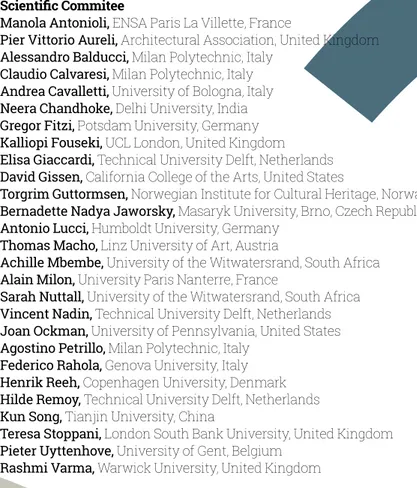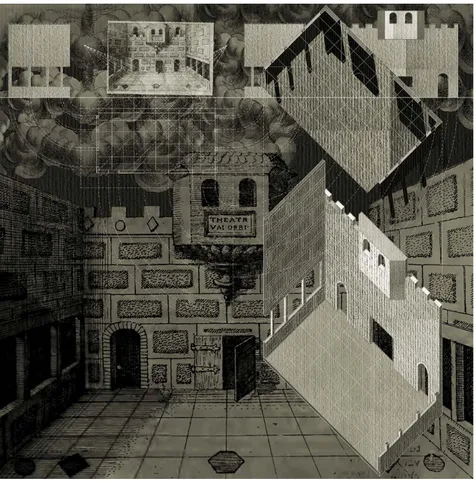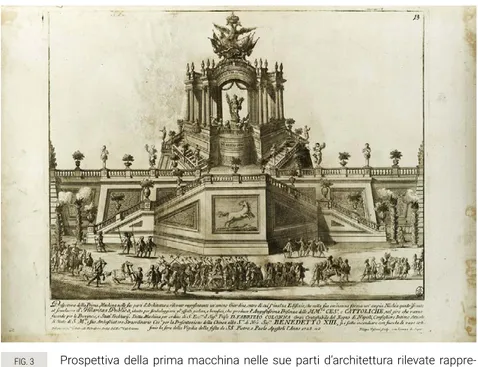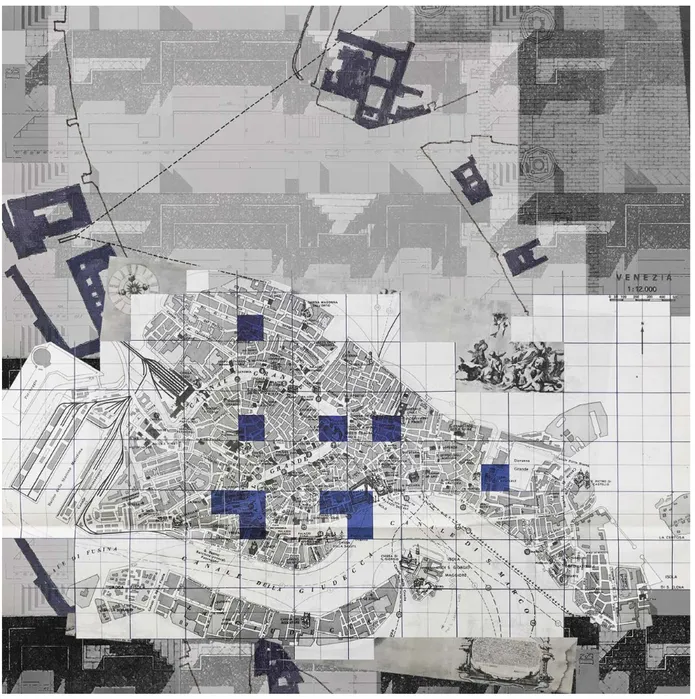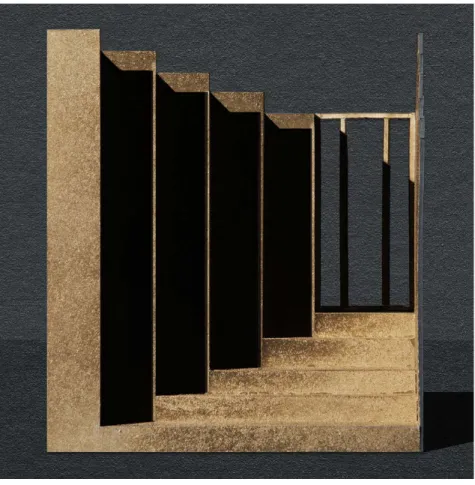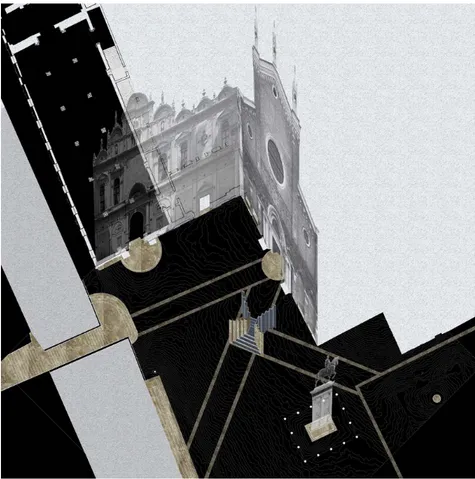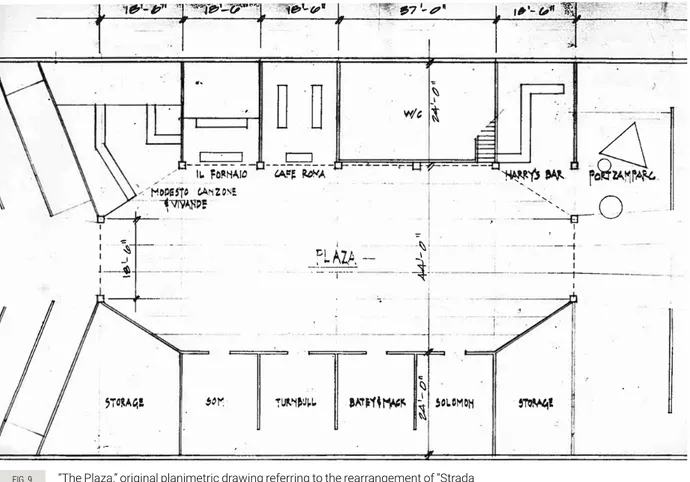CURATING THE CITY: ARTISTIC PRACTICES AND URBAN TRANSFORMATIONS Edited by Annalisa Trentin,
Anna Rosellini and Amir Djalali Cristina Garzillo, Anastasia Gkoliomyti, Leila Haghighat, Susan Holden, Peter Klimczak, Alessandro Mosetti, Ashley Paine, Guillermo Ruiz de Teresa, Michele Smargiassi, Ke Sun, Yoshiharu Tsukamoto.
Eiff
el
Tower and other buildings of the 1900 W
orld’
s F
air along the banks of the Seine, anonymous, 1900, sour
ce: http:/
/hdl.handle.net/10934/RM0001.COLLEC
ISSN 2612-0496 https://cpcl.unibo.it/
CURATING THE CITY:
ARTISTIC PRACTICES AND
URBAN TRANSFORMATIONS
Annalisa Trentin,
Anna Rosellini,
Amir Djalali,
Anastasia Gkoliomyti,
Yoshiharu Tsukamoto,
Alessandro Mosetti,
Guillermo Ruiz,
Ke Sun,
Leila Haghighat,
Ashley Paine,
Susan Holden,
Cristina Garzillo,
Peter Klimczak,
Michele Smargiassi
https://doi.org/10.6092/issn.2612-0496/v3-n1-2020n.1 2020
vol.3
Editors-in-Chief
Carola Hein, Delft University of Technology, Netherlands Giovanni Leoni, University of Bologna, Italy
Editors
Damiano Aliprandi, Fitzcarraldo Foundation, Italy Micaela Antonucci, University of Bologna, Italy
Audrius Banaitis, Vilnius Gediminas Technical University, Lithuania Andrea Boeri, University of Bologna, Italy
Alessandra Bonoli, University of Bologna, Italy Vando Borghi, University of Bologna, Italy Andrea Borsari, University of Bologna, Italy Francesca Bruni, City of Bologna, Italy Kelly Cotel, ICLEI – Eurocities, Germany
Gamze Dane, Technical University Eindhoven, Netherlands Roberto Falanga, University of Lisbon, Portugal
Maria Felidou, Athens School of Fine Arts, Greece Elisa Franzoni, University of Bologna, Italy Cristina Garzillo, ICLEI – Eurocities, Germany Jacopo Gaspari, University of Bologna, Italy Valentina Gianfrate, University of Bologna, Italy Giovanni Ginocchini, Urban Center Bologna, Italy Julie Hervé, Eurocities – ICLEI, Belgium
Jyoti Hosagrahar, UNESCO HQ, France Cécile Houpert, Eurocities – ICLEI, Belgium
Ana Ivanovska, SS. Cyril and Metodius University of Skopje, Republic of North Macedonia Arturas Kaklauskas, Vilnius Gediminas Technical University, Lithuania
Raffaele Laudani, University of Bologna, Italy Danila Longo, University of Bologna, Italy
Tino Mager, Technical University Delft, Netherlands Gino Malacarne, University of Bologna
Ognen Marina, SS. Cyril and Metodius University of Skopje, Republic of North Macedonia Joao Morais Mourato, University of Lisbon, Portugal
Valentina Orioli, University of Bologna, Italy
Panagiotis Pagkalos, Athens School of Fine Arts, Greece
Ana Pereira Roders, Technical University Eindhoven, Netherlands Chiara Gemma Pussetti, University of Lisbon, Portugal
Ania Rok, ICLEI – Eurocities, Germany Anna Rosellini, University of Bologna, Italy Ines Tolic, University of Bologna, Italy
Corrado Topi, University of York, United Kingdom Annalisa Trentin, University of Bologna, Italy
Michele Trimarchi, Magna Graecia University, Catanzaro, Italy Wout van der Toorn Vrijhoff, Technical University Delft, Netherlands Walter Vitali, Urban@IT, Italy
Managing Editor
Amir Djalali, University of Bologna, Italy Martina Massari, University of Bologna, Italy Federico Diodato, University of Bologna, Italy
ISSN 2612-0496 https://cpcl.unibo.it/
Alessandro Balducci, Milan Polytechnic, Italy Claudio Calvaresi, Milan Polytechnic, Italy Andrea Cavalletti, University of Bologna, Italy Neera Chandhoke, Delhi University, India Gregor Fitzi, Potsdam University, Germany Kalliopi Fouseki, UCL London, United Kingdom Elisa Giaccardi, Technical University Delft, Netherlands David Gissen, California College of the Arts, United States
Torgrim Guttormsen, Norwegian Institute for Cultural Heritage, Norway Bernadette Nadya Jaworsky, Masaryk University, Brno, Czech Republic Antonio Lucci, Humboldt University, Germany
Thomas Macho, Linz University of Art, Austria
Achille Mbembe, University of the Witwatersrand, South Africa Alain Milon, University Paris Nanterre, France
Sarah Nuttall, University of the Witwatersrand, South Africa Vincent Nadin, Technical University Delft, Netherlands Joan Ockman, University of Pennsylvania, United States Agostino Petrillo, Milan Polytechnic, Italy
Federico Rahola, Genova University, Italy Henrik Reeh, Copenhagen University, Denmark Hilde Remoy, Technical University Delft, Netherlands Kun Song, Tianjin University, China
Teresa Stoppani, London South Bank University, United Kingdom Pieter Uyttenhove, University of Gent, Belgium
Rashmi Varma, Warwick University, United Kingdom
Editorial Staff
Stefano Ascari, University of Bologna, Italy
Saveria Olga Murielle Boulanger, University of Bologna, Italy Matteo Cassani Simonetti, University of Bologna, Italy Ilaria Cattabriga, University of Bologna, Italy
Lorenzo Ciccarelli, University of Rome Tor Vergata, Italy Antony Colclough, EUROCITIES, Belgium
Felice Curci, University of Bologna, Italy Valentina Gianfrate, University of Bologna, Italy
Beatrice Lampariello, École Polytechnique Fédérale de Lausanne, Switzerland María de las Nieves López Izquierdo, University of Bologna, Italy
Viviana Lorenzo, University of Bologna, Italy Martina Massari, University of Bologna, Italy Sofia Nannini, Politecnico di Torino, Italy
Gabriele Neri, Accademia di architettura di Mendrisio, Università della Svizzera italiana, Italy Leila Signorelli, University of Bologna, Italy
Matteo Sintini, University of Bologna, Italy Yanchen Sun, Tianjin University, China Elena Vai, University of Bologna, Italy Francesco Volta, City of Bologna, Italy
Kaiyi Zhu, Technical University Delft, Netherlands
Graphic Design
Stefano Ascari, University of Bologna, Italy Maria Chiara Mazzoni, University of Bologna, Italy
European Journal of Creative Practices in Cities and Landscapes (CPCL) is scientific journal recognized by ANVUR (Italian National Agency for Evaluation of Universities and Research Institutes) for disciplinary areas 08 and 11. The Journal is indexed in the following databases and search engines: ANCP, BASE, Google Scholar, ROAD, Worldcat.
Vol.3 no.1| 2020 Vol.3 no.1 | 2020
MAIN SECTION
PEER REVIEWED
https://doi.org/10.6092/issn.2612-0496/10129 ISSN 2612-0496
Copyright © 2020 Alessandro Mosetti 4.0
Today, “urban regeneration” is often argued as being the only way to revitalize those urban sections of cities that have been forgotten or, one way or another, trivialized by consumer culture and tourism, both of which assault cities and tend to turn them into open-air fun-fairs. Instead, we should be suggesting a process of “regenerating the collective memory” of the city through public exhibitions, which was the intention behind the Venice Biennale and other cultural events instituted in cities during the ’70s and ’80s. How can such ephemeral architecture in the form of a public exhibition help in this endeavor? In the late ’70s, public exhibitions in Venice paved the way to a transparent methodology aimed at unifying both the Venetian and international vocations of the city’s Biennale, railing against the prevalent tendency towards a standardization of exhibitions. This aspect, today lacking, is one of the reasons why Venice is now perceived as an open-air museum rather than an active theatre for collective memory. Recovery, study, and a re-drafting of this geography of nonexistent places could offer a scenario of what might be recouped in the future as a methodology for upcoming exhibitions, in order to tackle the danger of Venice becoming a passive museum.
KEYWORDS
Strada Novissima; Venice Biennale; Ephemeral Architecture; Memory; Scenic Space
ABSTRACT
Alessandro Mosetti — IUAV (Italy) — Contact: [email protected]
Recognizing the Scenic
Value of the City: Ephemeral
Architecture as a Medium
to Evoke Urban Memories
FIG. 1
Introduction
This study assumes that all forms of ephemeral architecture for urban design are a meaningful mindset to intervene in the public spaces of the contemporary city. The case studies in this work have come from Venice which is an emblematic place where the use of ephemeral instances has long shaped the way of thinking about the urban role that an exhibition has when arranged/set up in a public space.
The theater is very similar to ephemeral architecture since both involve an event—its beginning, development, and conclusion. Without an event, there is no theater and no architecture.1
An ephemeral architecture project is nourished by the notion of mem-ory whenever it gives a scenic value to the city in which it is acting.2 This
corresponds to a strengthening of the theoretical link between scenog-raphy, architecture, and city, where the latter is none other than a theater and an object of representation. Considering this theoretical link as the foundation for any intervention in a city, urban ephemeral architec-ture can recover the naarchitec-ture of the city which it has always realized: this implies a reinforcement of the evocative power of buried memories while bringing out the meaning of the Latin term ephemerus. Far from being
1 Aldo Rossi, A Scientific Autobiography, transl. Lawrence Venuti (Cambridge, Mass.: MIT Press, 1981), 48.
2 Frances A Yates, The Art of Memory (Chicago: University of Chicago Press, 1966).
The lighthouse theatre with two scenes (Aldo Rossi, 1988), ©Eredi Aldo Rossi, courtesy Fondazione Aldo Rossi
Vol.3 no.1 | 2020 35
derogatory, its real significance can be perceived by analyzing its archetypical meaning. The term ephemerus3 represents the feverish power of a
moment perceived as the pinnacle of desire—the shortest temporality at the highest temperature. For the purposes of this research, the Latin defi-nition has been adopted since it adds the principle of reiterating the fever apex over a prolonged period to the notion of transience.
Theater or scenography, scenography or architecture, what other means represent history in the same way?4
The two quotes of Aldo Rossi connect the notion of the city, seen as a theater, to that of architecture seen as an actress.5 These events draw
nourishment from the history of the city by tallying urban memory with collective memory.6 By defining the architectural project as an actor, the
intention is to communicate a message or a mnemonic narration that is proper to the city theater, returning it to collectivity. In the preface to The
Architecture of the City, Eisenman refers to the city as a giant or collective
house of memory, which has a psychological reality arising from its being a place of fantasy and illusion, an analogue of both life and death as tran-sitional states.7 [Fig. 1]
Hence, the objective is to recover the meaning of the city as a theater of memory. Works of architecture making up the urban space are fundamen-tal elements within a scheme which recalls the ancient art of mnemotech-nics.8 Thus, the city is subject to the deposition of collective memory and
can serve as an atlas of our history.
3 Gian Biagio Conte, Emilio Pianezzola, and Giuliano Ranucci, “Ephemerus,” in Il Latino. Vocabolario della lingua latina (Milan: Le Monnier, 2010).
4 Alberto Ferlenga, Aldo Rossi: tutte le opere (Milan: Electa, 2000).
5 Architecture is conceivable, on an urban scale, as a theater. On the link between
scenography-architecture and the city, see Silvia Cattiodoro, Architettura scenica e teatro urbano, (Milan: FrancoAngeli, 2007).
6 Maurice Halbwachs and Lewis A. Coser, On Collective Memory, The Heritage of Sociology (Chicago: University of Chicago Press, 1992); Jacques Lacan, The Four Fundamental Concepts of Psychoanalysis (London: Routledge, 2018).
7 Peter Eisenman, “The House of Memory,” in Aldo Rossi, The Architecture of the City, transl. Diane Ghirardo and Joan Ockman (Cambridge, Mass.: MIT Press, 1982), 10.
8 Fabio Ferrucci, L’arte della memoria di Giordano Bruno. Il trattato “De umbris idearum” rivisto dal noto esperto di scienza della memoria (Milan: Anima, 2005).
Setting up, displaying, and dismantling
Urban ephemeral architecture acts in the field of brevity, but powerfully assumes the communicative urgency sought by the curator as the con-structive character of the stage set. Scenic architecture needs to be built as the representation of a story which, in turn, becomes a theatrical spec-tacle within the larger theater, namely, the city [Fig. 2].
If we hold onto the concept of mnemotechnics in the background when studying Rossi’s well-known projects for the Teatro del Mondo (Venice, 1979) and the Teatro Faro (Toronto, 1988) things become clearer. They allow us to explore two key issues: on the one hand, the object of commu-nication of which the set-up architecture is the spokesperson (i.e., a rep-resentation of urban memory) and, on the other, the construction of the scene within which the performance takes place (i.e. the scenography). The first project could be read9 in the light of Giulio Camillo’s Teatro della
Memoria described in his essay entitled L’Idea del theatro.10 Assuming that
the typological definition of the theater is a device supporting ars memoriae and in an indissoluble link with the architecture, Rossi’s Teatro del Mondo
9 Rafael Moneo, “L’apparenza come realtà. Considerazioni sull’opera di Aldo Rossi,” in Intorno ad Aldo Rossi e alla sua architettura, edited by Chiara Occhipinti (Milan: Politecnico di Milano, 2013), pp. 35–41.
10 Giulio Camillo, L’idea del theatro, edited by Lina Bolzoni, L’Italia 02 (Palermo: Sellerio Editore, 1991).
FIG. 2 Redrawing of the Theatrum Orbi as presented in Robert Fludd, “Ars memoriae” in Utriusque Cosmi. Maioris scilicet et minoris metaphysica, physica atque tech-nica Historia (Oppenheim: Hieronymi Galleri, 1617), 55
Vol.3 no.1 | 2020 37
is thus a work of architecture capable of narrating events which belong to the designer, the city, and the lagoon: a collection of memories acquired from the context and returned to it. On the other hand, the Toronto Teatro
Faro was depicted through drawings of two scenes—tragedy and
com-edy—which face each other simultaneously. The coexistence of tragedy and comedy in life, as well as in the city as theater, harks back to Serlio’s well-known urban scenes which did not slot them into a system of com-edy, satire and tragedy.11 The term ‘comedy’ can also suggest a playful
personality: close to the one Filippo Vasconi seemed to refer to when ded-icating his ephemeral architecture projects to the Roman Hilaritas publica [Fig. 3].
The city as a theatre stages all potential performances simultaneously, amending the vision of a fragmented torn city as represented in Rossi’s etching Architetture Assassinate dated 1975.12 Architecture takes part in
the game without a timeframe or memory of its place; it collects buried memories and returns them to the city, at which point collective memory reinterprets them. In the depths of the timeless design of the Analogous
City montage,13 Rossi exploited a system of memories of what had been
built and what was as yet unrealized, aiming to define a city which one could believe to have always inhabited. Likewise, the montage here is a paratext alongside the written body of the paper as the most effective
11 Sebastiano Serlio, Tutte l’opere d’architettura di Sebastiano Serlio, Bolognese: dove si trattano in disegno, quelle cose, che sono piu necessarie all’architetto (Venice: Francesco de Franceschi Senese, 1584).
12 See Rossi’s etching entitled Questo ora è perduto (1975).
13 Aldo Rossi, “La città analoga,” Lotus, no. 13 (1976): pp. 4–7; Manfredo Tafuri, “Cecì n’est pas une ville,” Lotus, no. 13 (1976): pp. 8–10.
FIG. 3 Prospettiva della prima macchina nelle sue parti d’architettura rilevate rappre-sentante un ameno giardino, entro di cui s’inalza edifizio, che nella sua eminenza forma un’ampia nicchia quadrifronte al simulacro di Hilaritas Publica, (Vasconi F., 1728), ©Biblioteca Casanatense, Roma.
way to highlight the psyche’s construction from which the portions of memories have emerged and how these returned to the reader.
This study illustrates several images made up of different techniques: montages by juxtaposition, overlapping of multi-temporal layers, photo-graphs of models, or drawings on an architectural scale; all images pur-suing the assemblage technique, unveiling their archetypal origin through a stratigraphic/iconographic excavation. If the representation staged by the architecture of the city speaks of memory and finds its correspond-ence in a theater in which every citizen is the main character, it seems obligatory to broaden the notion of temporality in order to fully understand the theoretical and compositional structure of urban ephemeral architec-ture. Temporality is a paramount factor in an architectural project which already postulates its finale in the planning phase. Splitting the tempo-rality of the project into the three acts identified by Rossi as “beginning,” “development” and “conclusion,” could prove more effective.14 However,
in the case of urban ephemeral architecture, this tripartition can also be symmetrically translated into “setting-up,” “displaying” and “dismantling.” It is interesting to note how the practice of rearranging an exhibition else-where introduces an unexpected fourth “act” with uncertain outcomes: although the event ends, the exhibition continues as a potential
monu-mentum. The practice of rearranging, relocating elsewhere and at other
times, can keep the ephemeral alive beyond the end of the exhibition.
Rearticulating Leoncilli’s
“Venezia e lo spazio scenico”
Up to this point, this investigation has shown the essential theoretical themes to frame a design methodology with ephemeral architecture at its center. In order to show the actual functioning of such a methodol-ogy, the study delved into two emblematic case studies, both generated in Venice: the set-up designed by Gian Carlo Leoncilli Massi for the Venezia
e lo spazio scenico exhibition (1979) and the rearranged set-up of Strada Novissima (under the name The Presence of the Past) at the Fort Mason
Center of San Francisco in 1982. For the first case study, the goal was to probe the fallout in mnemonic terms of a multi-scale scenic project built in line with the three “acts.” For the second one, the objective was to propose an analysis of the critical issues in staging the “fourth act.” This case study will be read in relation to the original act of the first version curated by Francesco Cellini and Claudio D’Amato in 1980 for the First International
Architecture Exhibition in Venice.
Gian Carlo Leoncilli Massi arrived in Venice in 1975 in a period that was critical both for Italian ephemeral architecture and the significant struc-tural changes in progress within the Venice Biennale. As a matter of fact,
Vol.3 no.1 | 2020 39
1975 marked the debut of the Architecture sector within the Biennale.15
On a large scale, Leoncilli is best known for his scenography projects for the Festival dei Due Mondi in Spoleto (1997, 1980, 1983). He graduated from the Sapienza University of Rome under Ludovico Quaroni; he trained as a teacher at the IUAV in Venice where he taught until 1987 when his research activity16 shifted to the Faculty of Architecture of the University
of Florence. The possibility of managing the set-up of the 1979 Theater-Architecture Biennale arose in Venice which had already seen active use of its public spaces for exhibition purposes.17 Suffice to observe what
occurred in Rome in those same years to clearly understand the struc-ture of the Venezia e lo spazio scenico exhibition. The first inkling came in 1977, the year of the Estate Romana by Renato Nicolini,18 who had
proposed an exhibition which narrated the historical city and paved the way for a process of maturation of what would begin in Venice two years hence: the recovery of lost urban memory, a thought on the active use of the city, far from being a museum only open to tourism. The ephem-eral medium adapts to these purposes and unfolds its meaning on two interconnected levels: a physical one and a mental one linked to time and the sedimentation of collective memory through the architectural project. Once again, the theater is seen as an architectural device to transform an ordinary public space into an extraordinary one.19
The second impulse was the well-known Roma Interrotta exhibition,20
mounted at Trajan’s Market in 1978 which inspired architectural drawings for a Rome much closer to a possible Analogous City,21 able to safeguard
the twelve mnemonic design archives of different origins. In the light of these projects, it is easier to understand the “renewed use of ephemeral architectural”22 which Paolo Portoghesi and Maurizio Scaparro discussed
15 At that time, Vittorio Gregotti was director of the Visual Arts sector. See the interview with Vittorio Gregotti in: Aaron Levy and William Menking, Architecture on Display: On the History of the Venice Biennale of Architecture (London: AA Publications, 2010).
16 Gian Carlo Leoncilli Massi, La composizione commentari (Venice: Marsilio, 1986); Gian Carlo Leoncilli Massi, L’etrusco torna a scrivere (Florence: Alinea, 1997); Gian Carlo Leoncilli Massi, La leggenda del comporre (Florence: Alinea, 2002).
17 In 1972, with the exhibition Sculptures in the City, the 36th Art Biennale took place in public spaces (campi, calli and courtyards) in order to exhibit large sculptures of composite material. During this period, the idea of the exhibition was to create a design laboratory or competition focusing on the city and its problems. On the Architecture Biennale seen as a design laboratory, see Aldo Rossi, Venice Project. Third International Exhibition of Architecture (Venice: La Biennale di Venezia, 1985), p. 13; Francesco Dal Co, Quinta mostra Internazionale di Architettura (Milan/ Venice: Electa, 1991).
18 Renato Nicolini, Estate romana (Siena: Sisifo, 1991); Renato Nicolini, Estate romana: 1976-85: un effimero lungo nove anni (Reggio Calabria: Città del Sole, 2011).
19 See the project for the “scientific theater” in Via Sabotino (1979) by Franco Purini and Laura Thermes.
20 Giulio Carlo Argan and Christian Norberg-Schulz, Roma interrotta (Rome: Officina Edizioni, 1978).
21 It is interesting to relate the work of Roma Interrotta to the exhibition 10 Immagini per Venezia: an event curated by Francesco Dal Co and held in Venice in 1981. See Francesco Dal Co, 10 immagini per Venezia (Roma: Officina Edizioni, 1980).
22 Paolo Portoghesi and Maurizio Scaparro, “Venezia teatro del Mondo,” in Venezia e lo spazio scenico, edited by Manlio Brusatin (Venice: The Venice Biennale, 1980), p. 7.
in the introduction to the official catalog of the Venezia e lo spazio scenico exhibition. The title of the exhibition summarizes the connection between the city and the theater.23 The exhibition set-up addressed the possibility
of building free ritual routes24 through the city’s intricate labyrinth:
[...] today there is a risk in a world that has become only image, that allegory is no longer intended “as a means, but as an end.” My interest consists in considering “Architecture as thought” or “building a thought in architecture” [...]25
In this way, Leoncilli’s project26 recognized the intricate link between the
play of memory27 and the scenic representation of the city (or
self-rep-resentation) by means of the scenic structuring of certain public places in Venice.28 When set up, the project went beyond the scale of the
architec-tural design and, as in the Roma Interrotta drawings, looked at the scale of the city as it turned itself into a multi-scale scenic project.29 Leoncilli’s
scenic program involved the selection of twelve sites for which he sug-gested specific settings. An iconographic representation of the city was necessary to highlight the routes and sites, and to this end Leoncilli pro-duced three plans to supplement the official exhibition catalog: Venezia
Storica (a historical map of Venice dated 1729), Venezia Attuale (a map of
Venice and its public transport network in 1979) and a Game of the Goose board [Fig. 4].
Just like Rome in the twelve panels by Giovanni Battista Nolli presented for Roma Interrotta, Venice is harnessed within a network of two hundred square meters where twelve sectors have been highlighted. The water-ways, the boat routes and pedestrian thoroughfares are shown on the grid. Aldo Rossi’s Teatro del Mondo is a part of this major network of places, standing as a visual pivot of Saint Mark’s Basin. The Game of the
Goose board set the rules for taking part as both designers and visitors;
the chosen sites are highlighted inside the boxes: each site evokes its historic scenic role. Within the urban grid, Leoncilli drew – at the scale
23 Ludovico Zorzi, “Intorno Allo spazio scenico veneziano,” in Venezia e lo spazio scenico, pp. 81–109; Ludovico Zorzi, Il teatro e la città: saggi sulla scena italiana (Turin: Einaudi, 1977). 24 On this point, see the 1975 Living Theater performance called Seven Public Acts–Seven Curses on Political Sadomasochism. This is a ritual procession that traveled through the city along the streets and across the squares to end up at the deconsecrated Church of San Lorenzo. 25 Gian Carlo Leoncilli Massi, Giovanni Fraziano and Aldo Rossi, I labirinti, le piazze, le porte e i velari, i ponti, i palazzi, le case, i giardini: architetture di Giancarlo Leoncilli Massi (Mantua: Casa del Mantegna, 1988), pp. 57–58. Translated by the author.
26 Leoncilli’s sketches for the exhibition are contained in: Ibid., pp. 44–45.
27 In the presentation of the exhibition in Domus, Marco Dezzi Bardeschi, describing Leoncilli’s project, quotes Giulio Camillo’s Teatro della memoria and Robert Fludd’s Ars Memoriae. See Marco Dezzi Bardeschi, “Venezia e lo spazio scenico,” Domus, no. 602 (1980): p. 8.
28 “The layout of Palazzo Grassi and the three periacts are the only pieces that it has been possible to make from the original project by Gian Carlo Leoncilli. Significant points were the Labirinto or La macchina del teatro in Saint Mark’s Square (gazing across at Rossi’s Teatro) and the gilded intrados of the Rialto bridge,” see Ibid.
29 Leoncilli’s drawings were made from 1:5000 to 1:25 scale, passing via a 1:200 scale to explain technical details and the precise location of the modules in the chosen areas.
Vol.3 no.1 | 2020 41
of the architectural plan – the basic exhibition module to be set up in its dimensional and formal variations at the chosen sites, in addition to the distinctive elements for Saint Mark’s Square, the Accademia di Belle Arti and the Rialto bridge:30 this is the periaktoi seen as an ephemeral
scenic space.
It is difficult to separate the compositional reading of this project from the chapter entitled Il gradino muschiato,31 written by Guglielmo Bilancioni
and inserted in the theoretical part of the official exhibition catalog:
30 See the brief description of the project in: Gian Carlo Leoncilli Massi, “Il sogno, La favola, La ragione e Il reale: temi per due progetti veneziani,” La nuova città, no. 2 (1996): pp. 24–29. 31 Guglielmo Bilancioni, “Tenore di verità nella festa veneziana,” in Venezia e lo spazio scenico (Venice: the Venice Biennale, 1980), pp. 69–70.
FIG. 4 Montage edited by the author including: an historic map of Venice (Ludovico Ughi, 1729) superimposed on the 200 square-meter grid; map of contemporary Venice (1979) showing the blue squares for which the ephemeral architecture project is proposed.
The geometry of the vortex, a theory of the abyss, the step, mark the existence of the omnivorous belly [...] the ground of stilt houses stuck [...].32
The periaktos [Fig. 5] are ephemeral scenic pieces of architecture reflect-ing an obsession with the step and its various archetypal meanreflect-ings: stone, stylobate, or the seat of an urban cavea. The twenty-five-centimeter-high step reaches its highest height where a small stage allows the speaker to address the public from a podium. The system of steps pivots on the ver-tical plane to define the image of a stage perceived by successive folds; the interior is golden. The significant event33 for Leoncilli’s project
coin-cided with the narration of the step: the latter archetype reinterpreted in a Venetian key became a compositional means for a scenic representa-tion of the scenography; the recognirepresenta-tion of the scenic value of Venice derived from a historiographic analysis of particular rites and customs which historically involved the same twelve sites identified by Leoncilli. Historical memory was added to the scenic value of the built surfaces, which shone through the quality of the scenic backdrops overlooking the
calli (streets), campi (squares) and intricate textures of the public land. 32 Ibid., 70.
33 Rossi, A Scientific Autobiography, p. 48.
FIG. 5 Volumetric abstraction of a single module of a periacto as it is taken from the drawings by Leoncilli related to the exhibition of “Venezia e lo spazio scenico” (1979). Concrete maquette made by the author, scale 1:50. Photographer: Umberto Ferro, Laboratorio fotografico (Labfot) Iuav
Vol.3 no.1 | 2020 43
A fenced-in urban theater, constituted by the stairs marking the boat docking places and those of the bridge, assumed a leading role [Fig. 7]. Thus, the exhibition was built by the periaktos and offered to the sponta-neous desire of tourists and citizens alike who could be the audience or actors of shows, concerts, and divertissements. The basic module was doubled or quadrupled in accordance with the dimensions of the availa-ble urban space, through iterative operations of dimensional multiplica-tion. The periaktos of Leoncilli were designed for Campo San Barnaba and
Ponte dei Pugni, Campo dell’Arsenale, Campo del Ghetto Novo, Campiello della Scuola di S. Giovanni Evangelista, Campo San Samuele, Campo San Fantin, Campo di San Giovanni e Paolo. In the San Fantin square, the
quad-ruple module was juxtaposed with the staircase leading to “La Fenice” with a forty-five-degree slope in a continuous vision of horizontal planes at different heights [Fig. 6]. In this case, the installation of the module enhanced the visual potency of the existing staircase by duplicating it. In other cases, the periaktos had the precise function of framing precious prospects, like optical machinery directing the view [Fig. 8].
In Campo dell’Arsenale, the three modules gazed at the two towers and the monumental portal. This set-up was repeated both in the square of the Scuola Grande di San Giovanni Evangelista, where two small modules peeked through the perforated wall, and at Campo San Samuele, where the modules looked towards Ca’ Rezzonico beyond the Grand Canal. In the
FIG. 6 Model of the double module as it is taken from the drawings by Gian Carlo Leoncilli Massi. related to the exhibition of “Venezia e lo spazio scenico” (1979), model in painted cardboard made by the author, scale 1:20. Photographer: Umberto Ferro, Laboratorio fotografico (Labfot) Iuav.
FIG. 8 Campo di San Giovanni e Paolo, axonometry with insertion of the quadruple module. Drawing and montage edited by the author, scale 1:200
FIG. 7 Campo San Fantin, axonometry with insertion of the quadruple module. Drawing and montage edited by the author, scale 1:200
Vol.3 no.1 | 2020 45
latter case, the public space of Campo San Samuele could be considered a complementary open-air exhibition pavilion linked to the large square courtyard of Palazzo Grassi. In addition, the montage analysis intro-duced a “telluric” principle which aimed to clarify the installation of cer-tain modules. The term “telluric” here indicated a precise desire to respect the morphology of the pavement by documenting its variations/differ-ences in height. For example, in Campo di San Giovanni e Paolo [Fig. 7] the quadruple element was positioned where the white limestone lines intertwined with those leading from the great dock on the canal to the church entrance. In the Ghetto square, the quadruple and double mod-ules were located at the southern and northern entrances to the island, gazing at each other through the trees and the three wells. Leoncilli’s pro-ject, only partially realized, sees full expression in the numerous authored drawings kept in the collection of the IUAV Projects Archive.34 Looking at
the proportions and modules in the drawings, the spatial features of the project—which did not garner critical success nor spark debate—achieved great consistency.
The fourth Act of Strada Novissima
If the exhibition by Leoncilli respected the three acts—introduced earlier as “setting up,” “displaying” and “dismantling”—the case of Strada Novissima brings us to the introduction of the “fourth act”: the “rearrangement.” Other ambitious architectural projects, aiming to define the new use of the ephemeral,35 were launched after the Venezia e lo spazio scenico
exhibi-tion. In this regard, it is worth recalling the exhibition of the event called
The Carnival of the Theater36 (1980) and promoted by the Biennale Theater
sector under the curatorship of Maurizio Scaparro. On that unique occa-sion, the carnival theme completely transformed the historical city center into a sequence of outdoor theaters, and improvised performances took place with the aid of scenographic and choreographic installations, includ-ing the “cobweb” of Donato Sartori37 which occupied the entire space of
Saint Mark’s Square. The set-up of Strada Novissima could be interpreted as a consequence of these events just described, among many others. By interpreting the project with a subtle sense of humor and without rely-ing on post-modernist language preconceptions, Strada Novissima sealed the success of the Venice Biennale as an institution at the forefront of the international debate on the theme of setting up architectural exhibi-tions. As Portoghesi highlighted, new problems concerning the lack of an authentic narration of Venice —let down by poor advertising—and mere
34 Project Archive: Venezia e lo spazio scenico (1979); location: box 20; shelf mark: BIAP/3/7. 35 Portoghesi and Scaparro, “Venezia e lo spazio scenico.”
36 Dario Ventimiglia, Il carnevale del teatro (Venice: The Venice Biennale, 1984).
37 Donato Sartori and Paola Pizzi, Maschere e mascheramenti. I Sartori tra arte e teatro (Padua: Il Poligrafo, 1996).
architectural self-representation38 arose together with the success of
the 1980 Biennale. That aside, La presence de l’histoire in Paris (Chapelle Saint-Louis de la Salpêtrière) in 1981 and The Presence of the Past in San Francisco (Fort Mason Center) in 198239 for the first time raised the
question of what their rearrangements meant. The problem is to medi-ate between the Venetian nature of the Biennale in each of its installa-tions and the emerging international vocation of its staging.40 The case of
Strada Novissima, which is dealt with here in its revised meaning from the
1982 Californian exhibition,41 was an experiment that aimed to transpose
an aspect of Venice’s nature overseas by means of the rearrangement technique. Whereas the location had changed, Venice’s nature remained, together with the same design principles of the original set-up: an ephemeral work of architecture composed in a void, named Plaza sim-ilar to the urban scenography designed by Vincenzo Scamozzi for the
Teatro Olimpico of Palladio in Vicenza. The exhibition site plan of the
38 Claudio D’Amato, Studiare l’architettura: un vademecum e un dialogo (Rome: Gangemi, 2014), p, 134.
39 The two events were curated for the Salon d’Automne (the 1981 Parisian edition) and a group of cultural institutions for the 1982 Californian edition involving: the SFMOMA, the San Francisco Italian Cultural Institute, the association Friends of the Biennale and the Fort Mason Center (Museum of Contemporary Art).
40 Paolo Portoghesi, The Projectual Offer (Venice: The Venice Biennale, 1985), 10–11. 41 Léa-Catherine Szacka, Exhibiting the Postmodern: The 1980 Venice Architecture Biennale (Venice: Marsilio, 2016).
FIG. 9 “The Plaza,” original planimetric drawing referring to the rearrangement of “Strada novissima” for “The Presence of the Past” exhibition held in San Francisco (1982). ©The Presence of the Past, Jr./MLTW Collection, 1959-1997, Environmental Design Archive.
Vol.3 no.1 | 2020 47
rearrangement illustrates a square encircled by traditional shops—given the name Italian Marketplace—in reference to Venice’s Rialto market which then segued into the Sponsor’s Pavilion (on the left) [Fig. 9].
If the façades were reassembled in Paris to define the space of a square, rather than a narrow street, in San Francisco, Venice’s linearity was re-pro-posed in a space similar to that of the Arsenale’s corderie building, but wider [Fig. 8]. What had nourished the Venetian edition was reinterpreted overseas. The resulting communication was ambiguous yet striking, bring-ing out an aspect that had had to be ignored in Venice: a spellbring-ing book to interpret the international postmodernist lexicon. In moving away from Venice, the same set-up was altered in its evocative power. In the case of the Parisian rearrangement, the theme was arranged through a rein-terpretation suggested by the central plan within which Strada Novissima was broken down. In the Californian case, there was a forced attempt
FIG. 10 AKROPOLIS IN MIAMI, Aldo Rossi, 1987, ©Eredi Aldo Rossi, courtesy Fondazione Aldo Rossi
to re-propose the Venetian linearity. There were two ways to intervene in the rearrangement: reinterpretation and forced revival. It is interesting to note that the Teatro del Mondo and Strada Novissima would meet again in the San Francisco bay42 during the Californian edition of The Presence of
the Past: an encounter which would have been impossible in Venice that
only bestowed additional power upon the rearrangement. There are many examples of reports relating the desire to rebuild the floating theater in the bay. The heavy swell of the ocean made it necessary to re-build the thea-tre on “bare rock.”43 At this point, it is useful to again mention the events44
that Aldo Rossi referred to, in order to define architecture, theater, and city. The Teatro del Mondo cyclically appeared in several design sketches outside Venice, probably more than any other ephemeral architecture produced by Rossi. For this reason, the desire to rebuild the theater in San Francisco was perfectly coherent. A similar outlook can be seen in a sketch for the New Architecture School of Miami University,45 where the
theater, no longer floating, rests on an actual pier [Fig. 10].
The theater is fed by the memories of the place it lives in, restoring a pre-cise Venetian nature, even though it is set elsewhere: it can be considered akin to the Theatrum orbi of Robert Fludd.46
Conclusion
The urban ephemeral architecture project brings out new issues regarding the place where it is taking place. If it receives the honor of the “fourth act,” its structure must necessarily change, overwriting new memories deriving from the new exhibition site. These projects are working tools for memory and remembrance: narrative projects that have the power to strengthen the link between the project itself and the place; indeed, this can even have a practical value in identifying and enhancing the construction and cultural characteristics of a given environment. This same power of evo-cation allows a glimpse of a militant goal in this category of architectural project. Assigning a scenic, theatrical and mnemonic responsibility to the project helps to understand its potential in terms of a “regeneration of urban memory” or an “evocation of urban memory.” Whereas the theoret-ical/practical discussion on the topic of urban regeneration seems to be inextricably linked to the concept of the mere reuse of abandoned spaces,
42 The archive documents are owned by the Environmental Design Archive of Berkeley University (EDA). The most interesting research materials have been transferred to the archive by William Turnbull (Jr./MLTW Collection, 1959–1997); collection number: 2000–9.
43 Information taken from correspondence dated 1982 between Friends of the Biennale and Fort Mason. William Turnbull Archive (Jr./MLTW Collection, 1959–1997); EDA, collection number: 2000-9.
44 Rossi, A Scientific Autobiography, p. 48.
45 See the design proposal for the Miami New School of Architecture (1986) and see also “Aldo Rossi makes his American debut (School of Architecture of Miami, Florida),” Architectural Record 175 (1987): p. 67.
46 Robert Fludd, Utriusque cosmi maioris scilicet et minoris metaphysica, physica atque technica historia (Oppenhemii: Hieronymi Galleri, 1617).
Vol.3 no.1 | 2020 49
it is enlightening that in the German context the concept of urban regener-ation is increasingly bound to the term Zwischennutzung47 translatable as
“temporary use.” Temporary use is one of the means to use urban spaces that are awaiting a project. The exhibition is one of the triggers of tem-porary use and must propose models and helpful thoughts for the con-struction of the city, while recognizing the prevailing culture of the times. Hence, ephemeral architecture reacquires its potential urban role which is to overcome its ambiguous nature of being considered a mere display.48
47 Philipp Oswalt, Klaus Overmeyer, and Philipp Misselwitz, eds., Urban Catalyst: The Power of Temporary Use (Berlin: DOM publishers, 2013).
48 Eeva-Liisa Pelkonen, Carson Chan, and David Andrew Tasman, eds., Exhibiting Architecture: A Paradox? (New Haven: Yale School of Architecture, 2015).
Alessandro Mosetti, Ph.D. candidate (Architectural Composition course at Iuav School of doctorate studies in Venice).
Vol.3 no.1 | 2020 51
References
Argan, Giulio Carlo, and Christian Norberg-Schulz. Roma interrotta. Rome: Officina Edizioni, 1978. Brusatin, Manlio. Venezia e lo spazio scenico. Venice: The Venice Biennale, 1980.
Camillo, Giulio. L’idea del theatro, edited by Lina Bolzoni. L’Italia 02. Palermo: Sellerio Editore, 1991. Cattiodoro, Silvia. Architettura scenica e teatro urbano. Milan: FrancoAngeli, 2007.
Conte, Gian Biagio, Emilio Pianezzola, and Giuliano Ranucci. “Ephemerus.” In Il Latino. Vocabolario della
lingua latina, 461. Milan: Le Monnier, 2010.
Dal Co, Francesco. 10 immagini per Venezia. Rome: Officina edizioni, 1980.
D’Amato, Claudio. Studiare l’architettura: un vademecum e un dialogo. Rome: Gangemi, 2014. Dezzi Bardeschi, Marco. “Venezia e lo spazio scenico.” Domus, no. 602 (1980): p. 8.
Ferlenga, Alberto. Aldo Rossi: tutte le opere. Milan: Electa, 2000.
Ferrucci, Fabio. L’arte della memoria di Giordano Bruno. Il trattato «De umbris idearum» rivisto dal noto
esperto di scienza della memoria. Milan: Anima, 2005.
Fludd, Robert. Utriusque cosmi maioris scilicet et minoris metaphysica, physica atque technica historia. Oppenhemii: Hieronymi Galleri, 1617.
Guy, Michel, Giuseppe Galasso, Monique Mosser, and Paolo Portoghesi. L’après Modernisme: La Présence
de l’histoire: Festival d’automne à Paris, La Biennal Di Venezia. Paris: L’Équerre, 1981.
Halbwachs, Maurice, and Lewis A. Coser. On Collective Memory. The Heritage of Sociology. Chicago: University of Chicago Press, 1992.
Lacan, Jacques. The Four Fundamental Concepts of Psychoanalysis. London: Routledge, 2018.
https://doi.org/10.4324/9780429481826
Leoncilli Massi, Gian Carlo. “Il sogno, la favola, la ragione e Il reale: temi per due progetti veneziani.” La
nuova città, no. 2 (1996): pp. 24–29.
———. La composizione commentari. Venice: Marsilio, 1986. ———. La leggenda del comporre. Florence: Alinea, 2002. ———. L’etrusco torna a scrivere. Florence: Alinea, 1997.
Leoncilli Massi, Gian Carlo, Giovanni Fraziano, Aldo Rossi. I labirinti, le piazze, le porte e i velari, i ponti, i
palazzi, le case, i giardini: architetture di Giancarlo Leoncilli Massi: 6 February - 6 March 1988. Mantua:
Casa del Mantegna, 1988.
Levy, Aaron, and William Menking. Architecture on Display: On the History of the Venice Biennale of
Architecture. London: AA Publications, 2010.
Nicolini, Renato. Estate romana. Siena: Sisifo, 1991.
———. Estate romana: 1976-85: un effimero lungo nove anni. Reggio Calabria: Città del Sole, 2011. Occhipinti, Chiara. Intorno ad Aldo Rossi e alla sua Architettura. Milan: Politecnico di Milano, 2013. Oswalt, Philipp, Klaus Overmeyer, and Philipp Misselwitz, eds. Urban Catalyst: The Power of Temporary
Pelkonen, Eeva-Liisa, Carson Chan, and David Andrew Tasman, eds. Exhibiting Architecture: A Paradox? New Haven: Yale School of Architecture, 2015.
Portoghesi, Paolo. Terza Mostra Internazionale Di Architettura: Progetto Venezia/The Venice Biennale. Venice: The Venice Bienniale, 1985.
Rossi, Aldo. Autobiografia scientifica. Nuovi Saggi. Parma: Pratiche Editrice, 1990. ———. “La città analoga.” Lotus, no. 13 (1976): pp. 4–7.
———. L’architettura della città. Padua: Marsilio, 1966.
Sartori, Donato, and Paola Pizzi. Maschere e mascheramenti. I Sartori tra arte e teatro. Padua: Il Poligrafo, 1996.
Serlio, Sebastiano. Tutte l’opere d’architettura di Sebastiano Serlio, Bolognese: dove si trattano in disegno,
quelle cose, che sono più necessarie all’architetto. Venice: Francesco de Franceschi Senese, 1584.
Szacka, Léa-Catherine. Exhibiting the Postmodern: The 1980 Venice Architecture Biennale. Venice: Marsilio, 2016.
Tafuri, Manfredo. “Cecì n’est pas une ville.” Lotus, no. 13 (1976): pp. 8–10.
———. “L’éphémère est éternel: Aldo Rossi a Venezia.” Domus, no. 602 (1980): pp. 7–12. Ventimiglia, Dario. Il carnevale del teatro. Venice: The Venice Biennale, 1984.
Yates, Frances A. The Art of Memory. Chicago: University of Chicago Press, 1966. Zorzi, Ludovico. Il teatro e la città: saggi sulla scena italiana. Turin: Einaudi, 1977.
———. “Intorno allo spazio scenico veneziano.” In Venezia e lo spazio scenico, edited by Manlio Brusatin, pp. 81–109. Venice: The Venice Biennale, 1980.
